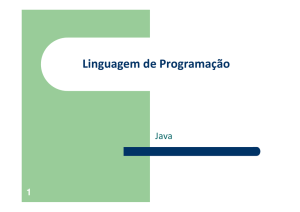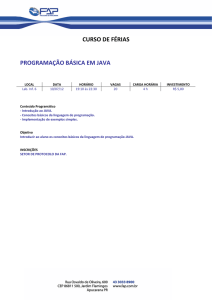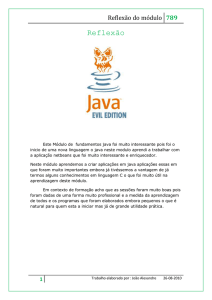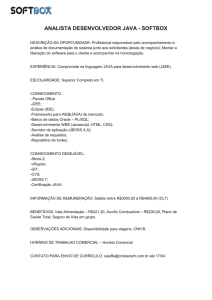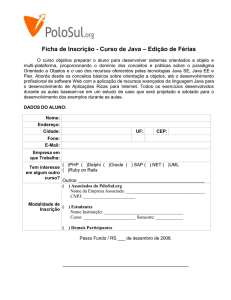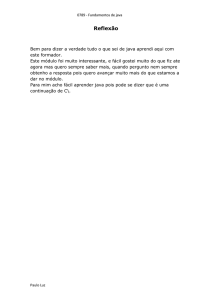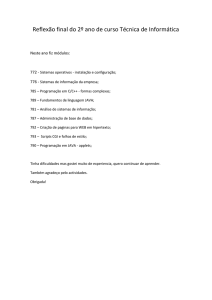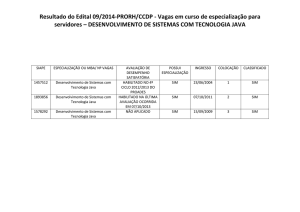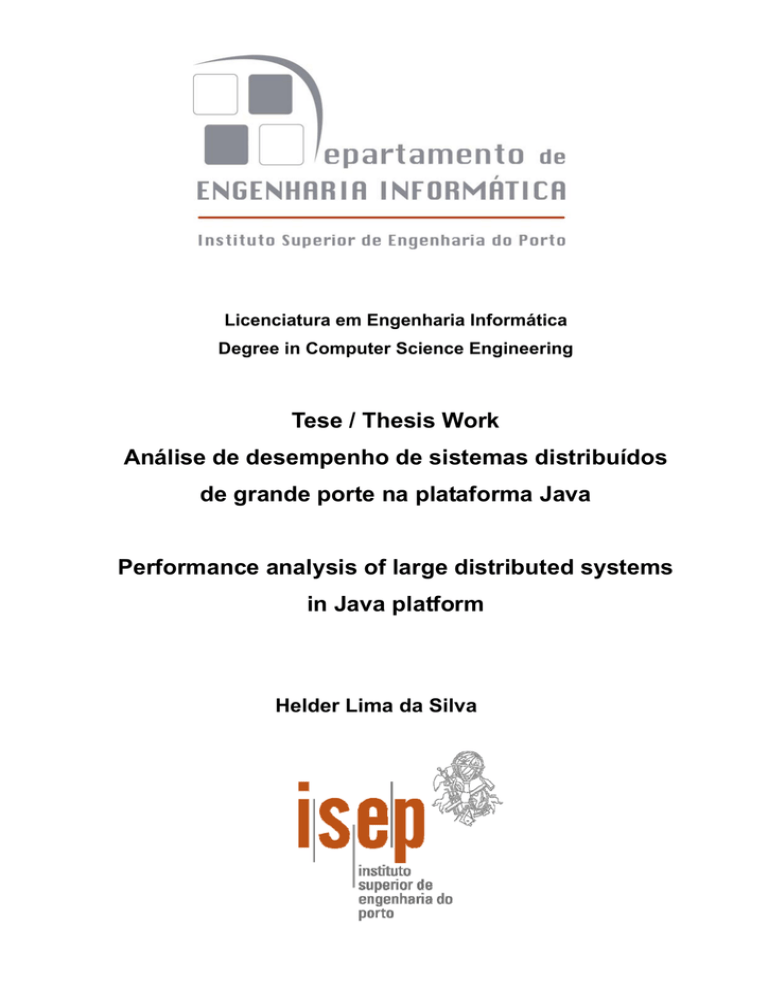
Licenciatura em Engenharia Informática
Degree in Computer Science Engineering
Tese / Thesis Work
Análise de desempenho de sistemas distribuídos
de grande porte na plataforma Java
Performance analysis of large distributed systems
in Java platform
Helder Lima da Silva
Licenciatura em Engenharia Informática / Degree in Computer Science Engineering
Tese / Thesis Work
Resumo
A plataforma Java vem sendo crescentemente adotada no desenvolvimento de
sistemas distribuídos de alta demanda de usuários. Este tipo de aplicação é mais
complexa pois necessita além de atender os requisitos funcionais cumprir os
parâmetros de desempenho pré-estabelecidos. Este trabalho realiza um estudo da
máquina virtual Java (JVM) abordando seus aspectos internos e explorando as
políticas de coleta de lixo existentes na literatura e as usadas pela JVM. Apresenta
também um conjunto de ferramentas que auxiliam a tarefa de otimizar aplicações e
outras que auxiliam no monitoramento das aplicações em produção.
Diante da grande quantidade de tecnologias que se apresentam para solucionar
problemas inerentes às camadas de aplicações, torna-se difícil realizar a escolha
daquela que possui o melhor tempo de resposta e o menor uso de memória. O trabalho
apresenta um breve referencial teórico de cada uma das possíveis tecnologias e realiza
testes comparativos através de uma análise estatística da variável aleatória do tempo
de resposta e das atividades de coleta de lixo.
Os resultados obtidos fornecem um subsídio para engenheiros e gerentes
decidirem quais as tecnologias a utilizarem em aplicações de grande porte através do
conhecimento de como elas se comportam nestes ambientes e a quantidade de
recursos que consomem. A relação entre produtividade da tecnologia e seu
desempenho também é considerada como um fator importante nesta escolha.
Palavras-chave: Desempenho, Máquina Virtual, Coleta de Lixo, WEB, Negócio,
Persistência, Struts, JSF, Hibernate, Comparação de Desempenho
Performance analysis of large distributed systems in Java platform Page 6 Licenciatura em Engenharia Informática / Degree in Computer Science Engineering
Tese / Thesis Work
Abstract
The Java Platform is increasingly being adopted in the development of distributed
systems with high user demand. This kind of application is more complex because it
needs beyond attending the functional requirements, to fulfill the pre-established
performance parameters. This work makes a study on the Java Virtual Machine (JVM),
approaching its internal aspects and exploring the garbage collection strategies existing
in the literature and used by the JVM. It also presents a set of tools that helps in the job
of applications in the production environment.
Due to the great amount of technologies that aim to solve problems which are
common to the application layer, it becomes difficult to choose the one with best time
response and less memory usage. This work presents a brief introduction to each one
of the possible technologies and realize comparative tests through a statistical analysis
of the response time and garbage collection activity random variables.
The obtained results supply engineers and managers with a subside to decide
which technologies to use in large applications through the knowledge of how they
behave in their environments and the amount of resources that they consume. The
relation between the productivity of the technology and its performance is also
considered as an important factor in this choice.
Keywords: Performance, Virtual Machine, Garbage Collection, WEB, Persistence,
Struts, JSF, Hibernate, Performance Comparison
Performance analysis of large distributed systems in Java platform Page 6 Licenciatura em Engenharia Informática / Degree in Computer Science Engineering
Tese / Thesis Work
Index
1. Introduction
1.1 Impact of the Execution Environment
1
………………………………….
3
1.2 Support Tools ………………………………………………………………… 3
1.3 Impact of application design ………………………………………………… 4
1.4 Organization of the text ……………………………………………………... 4
List of Symbols and Abbreviations ……………………………………………..
1
2. Java Virtual Machine and the garbage collection
5
2.1 Java Virtual Machine (JVM) ………………………………………………… 5
2.2 Java Virtual Machine in details …………………………………………….
7
2.2.1 The area of dynamic memory allocation (Heap) ………………….
9
2.2.2 Representation of objects ....................................................... ...
11
2.3 Garbage collection ................................................................................
11
2.3.1 Garbage Collection Algorithms ..................................................
11
2.3.2 Garbage collection and performance ........................................
16
2.4 Memory Leak .......................................................................................
3. Analysis tools and applications monitoring
19
21
3.1 JVMTI (Java Virtual Machine Tools Interface) …….….……………….
21
3.2 Profiler …………………………………………………….…………………
22
3.2.1 Use of Profilers in Java …………………………………………….
3.3 Management and applications monitoring ………………..………………
Performance analysis of large distributed systems in Java platform 23
26
Page 6 Licenciatura em Engenharia Informática / Degree in Computer Science Engineering
Tese / Thesis Work
4. Solutions and layers in the application context
4.1 Object-relational mapping layer ………………………………………….…
29
30
4.1.1 JDBC …………………………………………………………………..
31
4.1.2 Data Access Object …………………………………………………
32
4.1.3 Hibernate ...................................................................................
33
4.1.4 Application for performance comparison ....................................
34
4.2 Visualization layer ……………………………………………………………. 35
4.2.1 Struts ............................................................................................
37
4.2.2 JavaServer Faces – JSF ..............................................................
37
4.2.3 Application for performance comparison …………………………..
41
4.3 Business layer ………………………………………………………………..
42
4.3.1 Enterprise JavaBeans ………………………………………………..
43
4.3.2 Web Services ………………………………………………………….
44
4.3.3 Description of the calls with EJB and Web services ………………
44
4.3.4 Application for performance comparison ……………………………
47
5. Testing and performance analysis
50
5.1 Infrastructure for the testing ……………………………………………….
51
5.2 Results of experiments ……………………………………………………..
54
5.2.1 Results of the persistence layer ……………………………………..
54
5.2.2 Results of the visualization layer …………………………………….
58
5.2.3 Results of the business layer ………………………………………..
62
6. Conclusions
67
6.1 Comparative tests …………………………………………………………
68
6.2 Future works ........................................................................................
68
Bibliographic references
Performance analysis of large distributed systems in Java platform 69
Page 6 Licenciatura em Engenharia Informática / Degree in Computer Science Engineering
Tese / Thesis Work
A
B
Test Application - Layer Mapping
72
A.1
JDBC Test …………………………………………………………..
72
A.2
DAO …………………………………………………………………
73
A.3
Hibernate …………………………………………………………..
75
A.4
Class ………………………………………………………………..
75
A.5
Configuration ……..………………………………………………..
75
Test Application - Layer Visualization
76
B.1
JSP Test ………………………………………………………………..
76
B.2
Struts ……………………………………………………………………
76
B.2.1 Action ….………………………………………………………..
76
B.2.2 JSP …………………………………………………………….
77
JSF ……………………………………………………………………..
77
B.3.1 Managed Bean ………………………………………………..
77
B.3.2 Visualization ……………………………………………………
77
B.3
C
Application Testing - Business Layer
79
C.1
JavaBean ……………………..……………………………………..
79
C.2
EJB …………………………………………………………………….
79
C.2.1 Configuration .….……………………………………..
80
C.3
Web Service ……………………………………………………………
Performance analysis of large distributed systems in Java platform 81
Page 6


